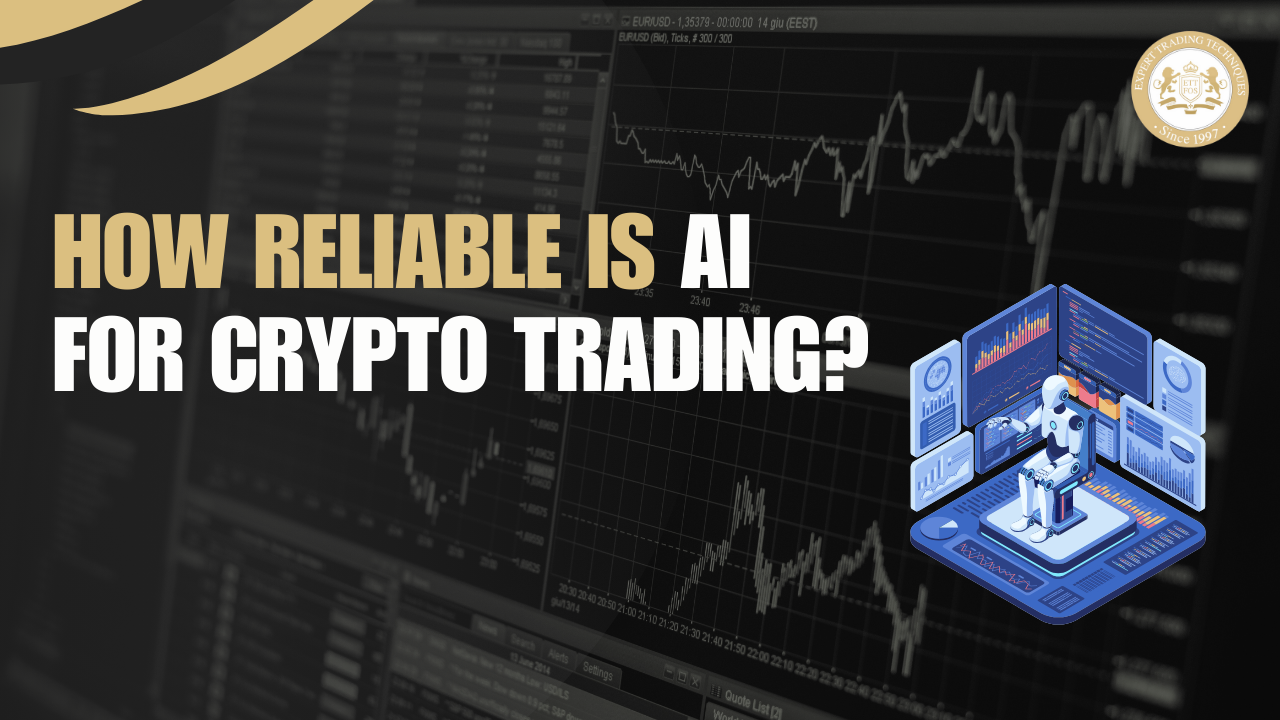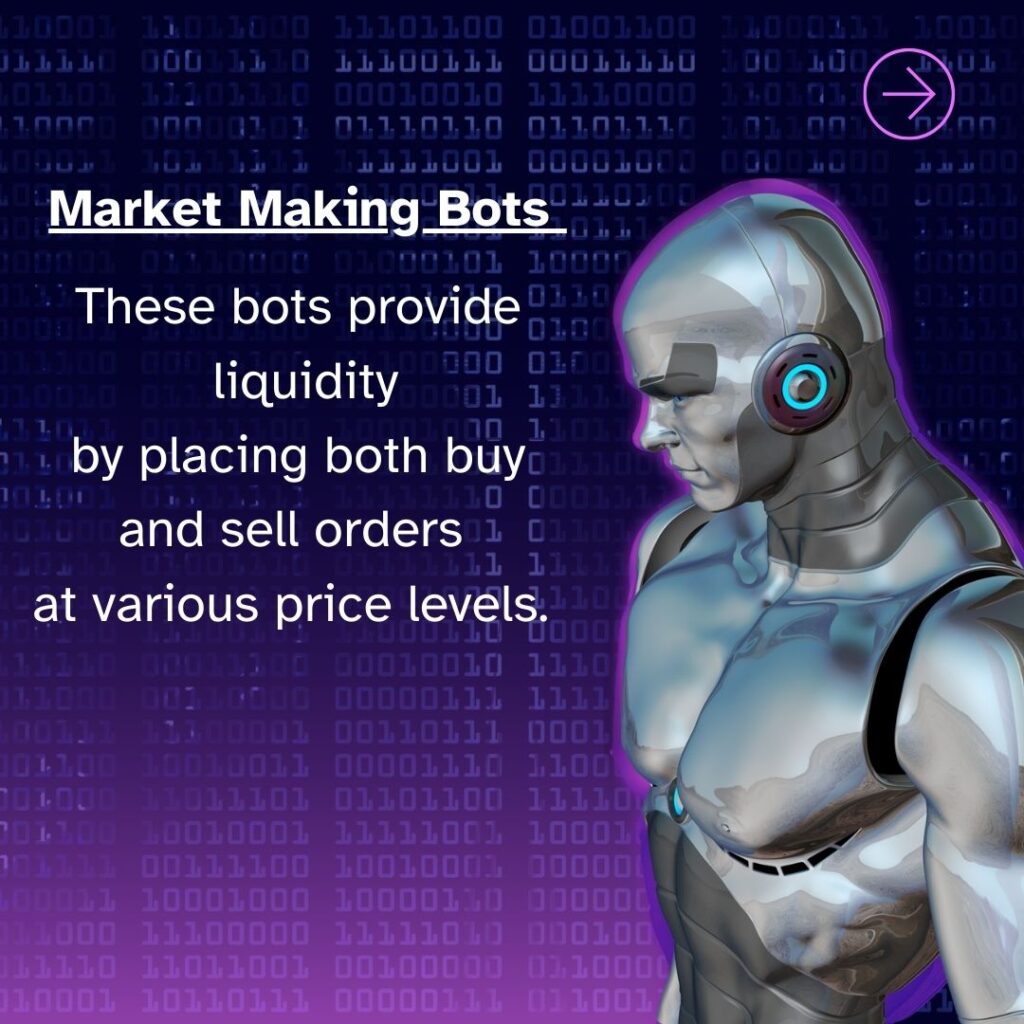
Picture this: you’re diving into the fast-paced world of cryptocurrency trading, where prices change in the blink of an eye. Now, imagine having a powerful tool that uses artificial intelligence (AI) to help you make smarter trades. AI can analyze huge amounts of data, spot trends, and even execute trades for you.
But here’s the big question: how reliable is AI when it comes to trading cryptocurrencies? Can it really give you an edge, or is it just another high-tech gadget with its own set of problems?
In this article, we’ll break down how AI works in crypto trading, look at its strengths and weaknesses, and compare it to traditional trading methods. Let’s explore whether AI can truly be your ally in the unpredictable world of crypto trading.
Also Read: Understanding What Is a Option In Stocks

Artificial Intelligence (AI) in crypto trading often called cryptotrading bots involves using computer programs to make smart trading decisions in the cryptocurrency market. Unlike humans, AI can quickly analyze massive amounts of data and make trades based on patterns and trends it finds. It also somewhat helps in recovering from crypto trading scams.
Think of it like having a supercharged trading assistant that never sleeps and can handle complex calculations in seconds. AI systems use a variety of techniques to predict market movements. For example, they might look at past price data, current market news, and even social media chatter to decide when to buy or sell a cryptocurrency.
In practice, this means an AI tool can spot opportunities and execute trades faster than a human trader. It helps in making data-driven decisions rather than relying on gut feelings or emotions. AI for crypto trading aims to improve accuracy and efficiency, giving traders a potential edge in a fast-paced and often unpredictable market.
AI for crypto trading bots come in various types, each designed for different trading strategies and needs. Here are the main ones:

These bots are designed to identify and follow market trends. They buy cryptocurrencies when prices are rising and sell when they are falling. Their goal is to ride the wave of a trend for as long as it lasts.

Arbitrage bots exploit price differences between different exchanges. For example, if Bitcoin is cheaper on one exchange compared to another, the bot buys it at the lower price and sells it at the higher price to make a profit.

These bots provide liquidity by placing both buy and sell orders at various price levels. They make a profit from the spread between the buying and selling prices. Market makers help keep the market liquid and efficient.

Mean reversion bots assume that prices will revert to their average over time. They buy cryptocurrencies when prices drop significantly below the average and sell when prices rise above the average.

These bots execute a large number of trades at very high speeds. They take advantage of tiny price movements and high trading volumes, making quick profits from small price changes.
Also Read: Why Should Youngsters Learn Crypto Trading?
In crypto trading, several key AI technologies help make smart trading decisions. Here’s a quick overview of the most important ones:
Machine learning allows AI systems to learn from past data and improve over time. It uses patterns in historical price data to predict future movements. For instance, ML algorithms might analyze years of price changes to spot trends and forecast where prices might go next.
NLP helps AI understand and analyze text from news articles, social media, and financial reports. This technology can gauge market sentiment by interpreting whether recent news or tweets are positive or negative about a cryptocurrency.
This involves using pre-set rules to automatically buy or sell cryptocurrencies based on specific criteria. For example, an algorithm might be programmed to buy a crypto asset if its price falls below a certain level and sell it when the price rises above another threshold.

AI tools in crypto trading work by following a systematic approach to analyze data and execute trades. Here’s a simple breakdown of how they do it:
First, AI for Crypto Trading tools gather a wide range of data. This includes historical price data, current market trends, news articles, and even social media updates. The more data the AI has, the better it can make informed decisions.
Once the data is collected, it needs to be cleaned and organized. This means turning raw data into a format that the AI can use for analysis. For example, converting news headlines into sentiment scores to understand their impact on the market.
The AI then analyzes this processed data using complex algorithms. It looks for patterns and trends that could indicate future market movements. For instance, it might identify a pattern that usually signals a price increase or decrease.
After analyzing the data, the AI tool makes trading decisions based on its findings. It then places buy or sell orders automatically on trading platforms. This happens much faster than a human could manage, often in milliseconds.
Traditional crypto trading strategies often face several challenges that can limit their effectiveness:
Traditional methods, which rely on manual analysis and decision-making, can be too slow for the fast-moving crypto market. Traders might miss out on opportunities or suffer losses because they can’t react quickly enough to market changes.
Human traders are prone to sentiment analysis to improve trading, emotional decisions, such as panic selling during a market drop or greedily holding onto gains. These emotions can cloud judgment and lead to poor trading choices. This leads to the mistakes that traders make during crypto trading.
Traditional strategies often rely on limited data and simple analyses. They may not account for the vast amount of data available, such as real-time news and social media sentiment, which can impact market movements.
Manual trading can be inconsistent due to factors like fatigue or distractions. This inconsistency can lead to missed trades or errors in executing strategies.
Many traditional strategies depend heavily on historical price patterns. However, the crypto market is highly volatile and can behave differently from past trends, making these strategies less reliable.
Also Read: What Are The Differences Between Forex and Cryptocurrency Trading?

When comparing traditional crypto trading to AI for crypto trading, here’s a straightforward breakdown:
| Aspect | Traditional Crypto Trading | AI Crypto Trading |
| Analysis Method | Manual analysis of charts, news, and data | Automated analysis using complex algorithms |
| Emotional Influence | Decisions can be affected by emotions (fear, greed) | Emotion-free, follows pre-set algorithms |
| Execution Speed | Trades executed manually, often slower | Fast, automated trade execution |
| Data Handling | Limited to historical price patterns and basic indicators | Handles vast amounts of data, including real-time news and social media |
| Decision Making | Based on trader’s experience and judgment | Data-driven, based on patterns and trends |
| Consistency | Can vary due to human factors and biases | Consistent, follows programmed strategies |
AI for crypto trading brings several key benefits to crypto trading, making it a powerful tool for traders:
AI for crypto trading can analyze market data and execute trades much faster than humans. This quick response helps capitalize on market opportunities and react to sudden changes without delay.
AI can sift through vast amounts of data, including price trends, trading volumes, and news. It identifies patterns and insights that might be missed by human traders, leading to more informed decisions.
Unlike human traders, AI for crypto trading doesn’t suffer from emotions or fatigue. It follows a set strategy consistently, reducing the risk of emotional decision-making and making trading more reliable.
AI trading systems can work around the clock, monitoring markets and making trades at any time. This constant vigilance helps capture opportunities in the highly volatile crypto market, even when human traders are offline.
Advanced AI systems can adjust their strategies based on new data and changing market conditions. This flexibility allows them to respond to evolving trends and maintain effectiveness in dynamic markets.
Also Read: Explore Stock vs Forex vs Crypto

While AI offers many advantages in crypto trading, it also comes with limitations and risks that traders should be aware of:
AI systems are only as good as the data and algorithms they use. If the data is flawed or the algorithms are poorly designed, the AI might make incorrect predictions or decisions.
The crypto market is extremely volatile and can change rapidly. AI may struggle to adapt to sudden market shifts or unexpected events, potentially leading to losses.
AI trading systems depend on technology, which can sometimes fail. Issues like software bugs, connectivity problems, or system glitches can disrupt trading and result in financial losses. For example, The 2010 Flash Crash, where the Dow Jones Industrial Average dropped dramatically in minutes due to high-frequency trading algorithms, highlights the risks of algorithmic trading failures.
AI lacks the nuanced understanding that human traders might have. It can miss context or subtleties in market conditions that could affect trading outcomes.
AI models trained on historical data might become too specialized to past conditions and fail to perform well in new or unusual market situations.
Also Read: Can I start crypto trading under $100?
People often ask, ‘can you lose money with crypto trading bots?’ The answer is, before diving into using an AI crypto trading bot, here are a few important steps to take:
Investigate different AI trading bots to understand their features, strengths, and limitations. Look for reviews and feedback from other users to gauge their performance and reliability. This is the advanced trading strategy pro traders use.
Clearly outline what you want to achieve with the bot. Whether it’s maximizing profits, minimizing risks, or automating trades, having specific goals will help you choose the right tool and set it up correctly.
Familiarize yourself with how the bot works. Learn about its algorithms, data sources, and trading strategies. This will help you better manage and adjust the bot according to your needs.
Many bots offer demo accounts or trial periods. Use these to test the bot’s performance and see how it handles real market conditions without risking actual money.
Establish clear risk management rules, such as stop-loss limits and maximum trade sizes. This will help protect your investments and prevent significant losses if the bot’s performance isn’t as expected.
Regularly review the bot’s performance and trading results. Even though the bot is automated, keeping an eye on its activities ensures it aligns with your trading strategy and goals.

Evaluating the reliability of AI tools for crypto trading involves a few key steps:
Look at important performance indicators like accuracy, return on investment (ROI), and risk-adjusted returns. Reliable tools should provide transparent data on how well they perform and how they handle risks.
Example Table:
| Metric | Description | Example Value |
| Accuracy | Percentage of correct predictions | 85% |
| ROI | Return on investment | 15% annual return |
| Risk-Adjusted Return | Return considering the risk involved | Sharpe Ratio of 1.5 |
See if the AI tool offers backtesting results. Backtesting involves running the tool’s strategies on historical data to check how they would have performed in the past. This helps gauge its potential effectiveness in different market conditions.
Research and compare different AI trading platforms. Look for features like the types of algorithms used, the quality of data, and ease of use. Some platforms offer more sophisticated tools and better performance metrics than others. For example, Platforms like Numerai and AlgoTrader offer various AI trading solutions, each with different features and pricing.
Check feedback from other users to understand their experiences with the tool. Reliable platforms often have positive reviews and active user communities that share insights and tips.
Look for reviews or opinions from industry experts. They can provide professional evaluations of the AI tool’s performance, reliability, and overall value.
Use any demo or trial version available. Testing the tool in real market conditions without risking real money helps assess its reliability and performance before committing fully.
Also Read: The Best Amount to Start Crypto Trading
There are several popular AI crypto trading tools that traders use to enhance their strategies and improve performance. Here are a few noteworthy ones:
3Commas offers a range of AI-powered trading bots that automate trading across multiple exchanges. It features smart trading terminals, portfolio management, and tools for setting up custom trading strategies.
Cryptohopper provides cloud-based trading bots with AI capabilities. It allows users to create trading strategies based on technical indicators and market signals, and it can operate 24/7 without manual intervention.
TradeSanta is another popular tool that automates trading on various exchanges. It uses AI to execute trades based on preset strategies and market conditions, and it offers features like grid trading and DCA (Dollar Cost Averaging) bots.
HaasOnline is known for its advanced trading bots and customizable strategies. It provides tools for backtesting, simulating trading strategies, and deploying bots across different cryptocurrency exchanges.
SharkBot focuses on user-friendly AI trading solutions with pre-configured strategies and easy setup. It’s designed for both beginners and experienced traders who want to automate their trading.

Looking ahead, AI and crypto trading are expected to evolve in several exciting ways:
AI algorithms will become more sophisticated, improving their ability to predict market movements with greater accuracy. Expect more advanced models that can analyze deeper patterns and adapt to changing market conditions.
AI tools will increasingly use big data, including social media trends and global news, to make more informed trading decisions. This broader data integration will help in better understanding market sentiment and potential impacts.
Future AI systems will offer enhanced risk management trading strategy trader should know, helping traders better control their exposure and protect against market volatility. These systems will be more adept at identifying and mitigating potential risks.
AI will enable more personalized trading strategies tailored to individual trader preferences and risk tolerance. Customized algorithms will adapt to personal trading styles and objectives.
AI and blockchain technology will work together more closely. AI could be used to analyze blockchain data for insights, while blockchain can enhance the transparency and security of AI trading systems.
As AI in crypto trading becomes more prevalent, we can expect increased regulation and compliance measures. This will ensure that AI tools are used ethically and transparently, protecting investors and maintaining market integrity.
AI in crypto trading offers numerous benefits, including speed, efficiency, and advanced data analysis. However, it also comes with risks such as over-reliance and market volatility. Evaluating AI tools requires careful consideration of performance metrics and user reviews.
AI has the potential to revolutionize crypto trading, but it’s important to use it as a tool rather than a crutch. Combining AI with human insight can lead to more balanced and effective trading strategies.
Ready to harness the power of AI in your trading? Explore our ETTFOS Core Masterclass to learn how our expert-led courses can help you master AI-driven trading strategies and make informed decisions in the cryptocurrency market.
AI enhances cryptocurrency trading performance by providing several key advantages. First, it operates with remarkable speed and efficiency, analyzing data and executing trades far quicker than human traders. This rapid response helps capture market opportunities and react to price changes instantly.
AI trading tools, while beneficial, come with their own set of risks. One major risk is over-reliance on algorithms, as the effectiveness of AI depends on the quality of its programming and data. Poorly designed algorithms or inaccurate data can lead to poor trading decisions. Additionally, the volatile nature of cryptocurrency markets can challenge AI systems, which may struggle to adapt to sudden market changes. Technical issues, such as software bugs or connectivity problems, can also disrupt trading and result in losses. Lastly, AI lacks the nuanced judgment of human traders, potentially missing critical market subtleties and external influences.
To assess the reliability of an AI trading system, start by examining its performance metrics, such as accuracy, return on investment (ROI), and risk-adjusted returns. Reliable systems should provide clear and transparent performance data. Additionally, review backtesting results, which simulate how the AI for crypto trading’s strategies would have performed using historical data. This helps gauge the system’s effectiveness across different market conditions. User reviews and feedback can also offer insights into the system’s reliability and real-world performance.